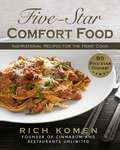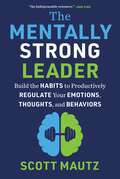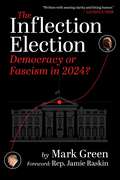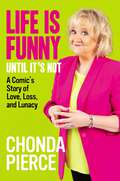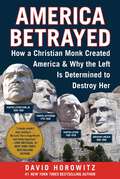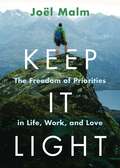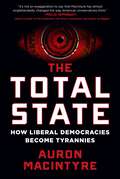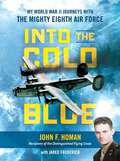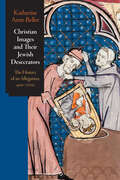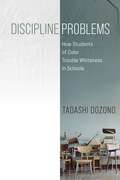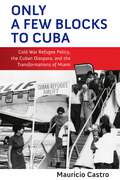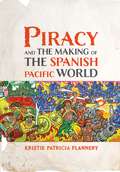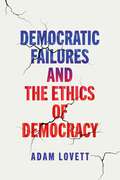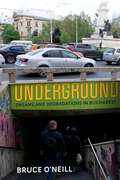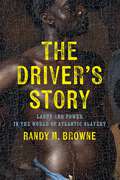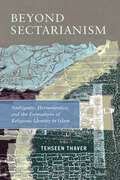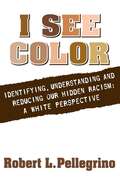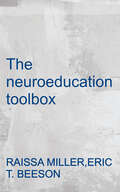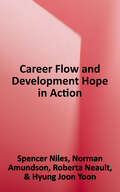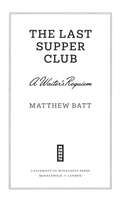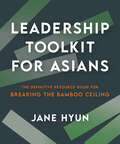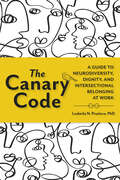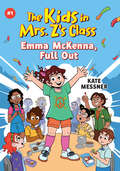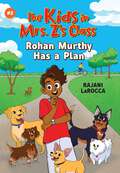- Table View
- List View
Five-Star Comfort Food: Inspirational Recipes for the Home Cook
by Rich KomenAmerica loves to eat. And eat good. From Slow Cooker Goulash with Parsley Pasta to the most amazing Kung Pao Chicken, Five-Star Comfort Food ushers us into this wonderful world of America&’s best homemade food and five-star recipes. Renowned restauranteur and founder of Cinnabon Rich Komen has culled ninety of his favorite recipes from his culinary treasure trove to delight home cooks at every level. Rich is an outstanding cook, which he finds to be a fun part of his day and an interesting hobby. He&’s now eager to share his collection of award-winning recipes, which feature easy-to-follow instructions and easy-to-find ingredients. Some of the notable dishes include: Dungeness Crab and Artichoke Dip Garden Fresh Tomato Soup Pappardelle with Chicken Ragu, Fennel, and Peas Peppercorn-Crusted Roast Beef Citrus-Braised Pork with Crispy Shallots Pan-Seared Chicken with Riesling Cream Sauce, Chanterelles, and Chard Veracruz-Style Red Snapper Roasted Cauliflower Steaks Thyme-Scented Potato Gratin Prize-Winning Apple Pie From tasty appetizers to satisfying main dishes and down-home desserts, Five-Star Comfort Food offers a hefty helping of fabulous food for every taste.
The Mentally Strong Leader: Build the Habits to Productively Regulate Your Emotions, Thoughts, and Behaviors
by Scott Mautz&“If you want to build the mental resilience to thrive under pressure and drive change despite obstacles, this book will prove an indispensable resource again and again."—Daniel H. Pink, #1 New York Times bestselling author of The Power of Regret, When, and To Sell is Human Manage yourself internally so you can lead better externally Award-winning, bestselling author Scott Mautz defines mental strength as the ability to self-regulate emotions, thoughts, and behaviors to achieve exceptional outcomes, despite adversity. It&’s the leadership superpower of our times. Mentally strong leaders are confident and in control of themselves and their environment; they have endurance, are disciplined, and external stressors make their decision-making sharper. They&’re a safe port in a storm for their team.The Mentally Strong Leader gives readers a mental exercise plan to become such a leader. Readers will walk away with a menu of over 50 proven tools they can choose from to build a tailored set of habits in six areas that will make them mentally stronger: Fortitude Decision-making Confidence Goal-focus Boldness Messaging Inspired by Mautz&’s hit LinkedIn Learning course, &“10 Habits of Mentally Strong People,&” his 25 years leading some of Procter & Gamble&’s multi-billion-dollar businesses, and over 30 years of studying this topic, The Mentally Strong Leader relies on mental models, data and research, habit-building science, and practical tools and exercises to create enduring understandings for readers. Mautz begins with a compelling explanation of the power of mental strength, and offers a Mental Strength Self-Assessment. He finishes, as he has in his past titles, like Leading from the Middle, and Make it Matter, by providing a Mental Action Plan (MAP) to help readers create their own, tailored practice.
The Inflection Election: Democracy or Fascism in 2024?
by Mark GreenRep. JAMIE RASKIN (D-MD): &“This fine book is an essential primer about the stakes in &’24. We owe Mark a debt of gratitude.&”LAURENCE TRIBE: &“Written with searing clarity and biting humor.&” The Inflection Election: Democracy or Fascism in 2024? aims to warn busy and credulous Americans that this November will be a choice between a Party of Progress and a Party of Dangerous Extremism that may determine the path for American governance for generations. This is not a &“both-sides&” analysis by a journalistic spectator, but is instead a blunt &“one-sided&” guide by an experienced partisan—a public interest lawyer, elected Democrat, and prolific author. Mark Green makes the case for Democracy and Freedom and against Trump&’s blatant Caesarism and MAGA&’s fringeworthy agenda. While neither side has a prohibitive advantage as of mid-2024, the stakes are no mystery. If the GOP should now win both the White House and Congress—with a reactionary Supreme Court already in its column—a numerical minority of Americans would then enjoy a temporary governing majority that could cancel a century of progress and make the world&’s oldest democracy no longer democratic. There must be a word that binds together such threats but it sure isn't &“conservative&” in the way Eisenhower, Reagan, or the Bushes would have understood it. For if all the corruption, lies, violence, and racism described throughout The Inflection Election were aggregated into a pointillist painting, the portrait would resemble Orbán far more than Obama. This is extremism posing as patriotism . . . whether it&’s called fascism, dictatorship, autocracy, or authoritarianism. While the country can hope that the courts will hold Trump accountable, Green concludes that crushing it in 2024 is the best way to return to a healthy two-party system where losers respect the choice of voters, like in the good old days of 1789–2020. In a likely close 2024 national contest, The Inflection Election is an entertaining and informative manifesto that will become part of this year&’s urgent political conversation. It is a one-stop primer that synthesizes fresh phrases, narratives and values to keep Democrats on offense and Trump&’s MAGA party on-the-ropes. Green&’s conclusion is that the GOP &“sounds like a casting call for the delirious jury in the classic film Idiocracy, which was supposed to be a satire on reverse Darwinism, not reality TV.&” November 5, 2024 is either/or time. This book explains why.
The Emergency Diaries: Stories from Doctors Inside the ER
by Northwell's Staten Island University HospitalHarrowing and hopeful tales from doctors inside the emergency room at Staten Island University Hospital—one of the flagship hospitals of Northwell Health, New York&’s largest health care provider Open 24 hours a day, 365 days a year—through winter storms, hurricanes, and global pandemics—emergency rooms are vital to the safety of any community. Day in and day out, thousands of patients pass through their doors to address their immediate medical needs. From life-threatening illnesses to minor ailments, ER doctors and nurses are the first line of defense when something goes wrong with our bodies. Written as a series of essays and stories by real ER doctors, The Emergency Diaries gives readers a glimpse into the hearts and minds of medicine&’s finest, and the seemingly insurmountable challenges these everyday heroes face. Doctors recount firsthand the challenging nature of their profession and share pivotal moments in their medical careers that have stuck with them to this day. Whether it&’s delivering the bad news or making split-second decisions to save lives, the extremes of this profession can be overwhelming. ER doctors and nurses are under incredible pressure to act with grace, precision, and mental fortitude when caring for their patients. Larger national events—like the opioid epidemic, natural disasters, and the coronavirus pandemic—have only exacerbated this stress in recent years. This poignant-yet-hopeful book tells their stories and serves as a testament to their incredible resilience and sacrifice for the greater good.
Life Is Funny Until It's Not: A Comic's Story of Love, Loss, and Lunacy
by Chonda PierceOne of America&’s funniest women opens up in this real and raw memoir, encouraging readers to face life&’s trials with unshakeable faith and joy.A stand-up comedian beloved for her combination of feisty wit and Southern charm, Pierce knows all too well that life is funny—until it&’s not. But she also knows that it will become funny again. She&’s held on to that hope—and that promise—through tragedy and triumph.And now she&’s finally ready to tell her full story.In Life Is Funny until It&’s Not, Pierce recounts a preacher&’s daughter&’s childhood filled with heartbreak, including abuse, her parents&’ divorce, and the sudden deaths of her two sisters in the span of two years. Even after she achieved success in her comedy tours, trials and tragedy dogged her through marriage, motherhood, and widowhood. But God was there with her through every sorrow and every joy.This story of unshakeable hope and faith will inspire readers to turn to God and trust his faithfulness.Chonda Pierce has a white-knuckle faith—the kind you almost dare to have taken from you. And she wants her readers to share her unapologetic courage to hope—as well as a few laughs along the way.
America Betrayed: How a Christian Monk Created America & Why the Left Is Determined to Destroy Her
by David HorowitzAmerica is now engulfed in a crisis that goes to the very foundations of its democracy. To destroy Americans&’ pride in their heritage and undermine their will to defend it, the attacks on America&’s heritage begin with malicious slanders intended to turn the American dream of equality and freedom into a &“white supremacist&” nightmare. We are told America, from its inception, has been a &“racist&” nation that treats minorities as less than human. We are told America deserves to be destroyed. This destructive lie is now the official doctrine of the Biden White House, the &“woke&” Pentagon, the Democratic Senate, and the curricula of American schools. America Betrayed restores the true history of America&’s achievements and its role as a beacon of freedom. Framed by an account of Martin Luther&’s history and ideas, David Horowitz demonstrates that racial progress in America originates not from Leftist policy but from its founding ideals. America Betrayed is a history and a manifesto focused on the current war to save our country and restore the dignity and freedom of the individual.
Keep It Light: The Freedom of Priorities in Life, Work, and Love
by Joël MalmOverwhelmed? Tired? Feel like you can&’t keep up? Jesus promises that His burden is light, but how many of us are actually feeling, well … light? If life is like a long hike, most of us feel like we have a giant backpack of responsibilities and burdens that weigh us down and take the joy out of living. But Jesus offers another way.Keep It Light will help you: Prioritize what deserves your time, money, and energy in this season of life Develop a plan to give your best to what matters most right now Balance the demands on your resources so there&’s time and energy for what you love most Create a stewardship plan to make sure that what God values is your highest priority If the burden of life feels too heavy to handle, there&’s a good chance you&’re carrying something you weren&’t meant to carry alone.
The Total State: How Liberal Democracies Become Tyrannies
by Auron MacIntyreThe Total State pulls back the veil on the new American authoritarianism and why the same system of liberal democracy we say we cherish may have led us to our present state The modern United States is a nation full of censorship, lockdowns, riots, and political persecution. How did the land of the free become a surveillance state terrified of COVID and ruled by unaccountable bureaucrats? As a journalist, Auron MacIntyre witnessed firsthand the manipulation of news events, the bias of the press, and the relentless assault on truth during the Donald Trump presidency. Yet, it wasn't until the arrival of the COVID-19 pandemic in 2020 that his worldview was irrevocably shaken. The emergency measures and unchecked power wielded by authorities revealed a dark underbelly that defied the constitutional safeguards he had always believed in.The Total State delves into the core of MacIntyre's ideological crisis, exploring the erosion of individual liberties in the name of public health and the new brand of American authoritarianism that revealed itself under a state of emergency. Drawing inspiration from a diverse array of thinkers outside the mainstream, MacIntyre questions the narrative that has been ingrained in our political discourse. What if democracy doesn&’t limit government but instead helps it to expand? What if the Constitution failed to restrain power as intended?The Total State doesn't offer easy answers, but it poses essential questions about the trajectory of our nation. MacIntyre meticulously examines the forces that have shaped our current reality, urging readers to confront uncomfortable truths about the state of our democracy and individual freedom. This thought-provoking exploration is a call to action, encouraging readers to understand the roots of our present predicament and contemplate the challenging path forward.
Into the Cold Blue: My World War II Journeys with the Mighty Eighth Air Force
by John F. Homan Jared FrederickOne of the last great memoirs of World War II, Into the Cold Blue is a riveting account of the air war over Europe, when hell was four miles above the earth. A born daredevil, John Homan joined the Army Air Forces after the Pearl Harbor attack. By 1944, he was co-piloting a B-24 Liberator over Nazi Germany, raining death and destruction on the enemy. This first-person account of his harrowing missions—chronicling deadly flights through skies of red-hot flak bursts and airmen bailing out with parachutes aflame—will leave readers staggered by the determination and grit of World War II aviators. Fighting a fierce enemy in the air seemed the perfect way for Homan to channel his restless, energetic spirit in wartime, but he could never have imagined the horrors that awaited him. During a vast operation over Nazi-occupied Holland in September 1944, his plane was punched full of holes, its left tail shot away, and a tire blown to bits. Homan wondered how he could possibly survive. The young lieutenant and his exhausted crewmates braced for a nearly hopeless emergency landing. Meanwhile, across the Atlantic, waited the sweetheart he thought he&’d never see again. With wit, warmth, and astonishing clarity, John Homan conveys the skill and heroism of the &“Mighty Eighth&” Air Force in the most perilous theater of history&’s greatest air war.
Christian Images and Their Jewish Desecrators: The History of an Allegation, 400-1700 (Jewish Culture and Contexts)
by Katherine Aron-BellerIn Christian Images and Their Jewish Desecrators, historian Katherine Aron-Beller analyzes the common Christian charge that Jews habitually and compulsively violated Christian images, identifying this allegation as one that functioned alongside other anti-Jewish allegations such as ritual murder, blood libel, and host desecration to ultimately inform dangerous and long-lasting prejudices in medieval and early modern Europe. Through an analysis of folk tales, myths, legal proceedings, and religious art, Aron-Beller finds that narratives alleging that Jews committed violence against images of Christ, Mary, and the disciples flourished in Europe between the fifth and seventeenth centuries. She then explores how these narratives manifested differently across the continent and the centuries, finding that their potency reflected not Jewish actions per se, but Christians’ own concerns about slipping into idolatry when viewing depictions of religious figures. In addition, Aron-Beller considers Jews’ own attitudes toward Christian imagery and the ways in which they responded to and rejected—or embraced—such allegations. By examining how desecration allegations affected Jewish individuals and communities spanning Byzantium, medieval England, France, Germany, and early modern Spain and Italy, Aron-Beller demonstrates that this charge was a powerful expression of the Christian majority’s anxiety around committing idolatry and their eagerness to participate in practices of veneration that revolved around visual images—an anxiety that evolved through the centuries and persists to this day.
Discipline Problems: How Students of Color Trouble Whiteness in Schools
by Tadashi DozonoAngel, a Black tenth-grader at a New York City public school, self-identifies as a nerd and likes to learn. But she’s troubled that her history classes leave out events like the genocide and dispossession of Indigenous people in the Americas, presenting a sugar-coated image of the United States that is at odds with her everyday experience. “The history I learned in school is simpler,” she says. “The world I live in is a lot more complex.”Angel, like every student interviewed in Discipline Problems, has been identified by teachers as a “troublemaker,” a student whose behavior disrupts classroom norms and interferes with instruction. But her critiques of the curriculum she’s taught speak to her curiosity and insight, crucial foundations for understanding history. Like many students who have been marginalized by systemic racism in American schools, she exposes the shortcomings of her classrooms’ academic environments by challenging both the content and the methods of her education. All too often, these challenges are framed as “troublemaking,” and the students are disciplined for “acting out” instead of being rewarded for their intellectual engagement.Tadashi Dozono, a professor of education and former high school social studies teacher, takes seriously the often-overlooked critiques that students of color who get labeled as troublemakers direct toward their high school history curriculum. He reinterprets “troublemaking,” usually cast as a behavioral deficit, as an intellectual asset and form of reasoning that challenges the “disciplining reason” of classrooms where whiteness is valued over the histories and knowledge of people of color. Dozono shows how what are traditionally framed as discipline problems can be seen through a different lens as responses to educational practices that marginalize non-white students. Discipline Problems reveals how students of color seek out alternate avenues for understanding their world and imagines a pedagogy that champions the curiosity, intellect, and knowledge of marginalized learners.
Only a Few Blocks to Cuba: Cold War Refugee Policy, the Cuban Diaspora, and the Transformations of Miami (Politics and Culture in Modern America)
by Mauricio Fernando CastroIn Only a Few Blocks to Cuba, Mauricio Castro shows how the U.S. government came to view Cuban migration to Miami as a strategic asset during the Cold War, in the process investing heavily in the city’s development and shaping its future as a global metropolis.When Cuban refugees fleeing Communist revolution began to arrive in Miami in 1959, the city was faced with a humanitarian crisis it was ill-equipped to handle and sought to have the federal government solve what local politicians clearly viewed as a Cold War geopolitical problem. In response, the Eisenhower and Kennedy administrations, and their successors, provided an unprecedented level of federal largesse and freedom of transit to these refugees. The changes to the city this investment wrought were as impactful and permanent as they were unintended. What was meant to be a short-term geopolitical stratagem instead became a new reality in South Florida. A growing and increasingly powerful Cuban community contested their place in Miami and navigated challenges like bilingualism, internal political disputes, socioeconomic polarization, and ongoing struggles and negotiations with Washington and Havana in the decades that followed. This contested process, argues Mauricio Castro, not only transformed South Florida, but American foreign policy and the calculus of national politics.Castro uses extensive archival research in local and national sources to demonstrate that the Cuban diaspora and Cold War refugee policy made South Florida a key space to understanding the shifting landscape of the late twentieth century. In this way, Miami serves as an example of both the lived effects of defense spending in urban spaces and of how local communities can shape national politics and international relations. American politics, foreign relations, immigration policy, and urban development all intersected on the streets of Miami.
Piracy and the Making of the Spanish Pacific World (The Early Modern Americas)
by Kristie FlanneryPiracy and the Making of the Spanish Pacific World offers a new interpretation of Spanish colonial rule in the Philippine islands. Drawing on the rich archives of Spain’s Asian empire, Kristie Patricia Flannery reveals that Spanish colonial officials and Catholic missionaries forged alliances with Indigenous Filipinos and Chinese migrant settlers in the Southeast Asian archipelago to wage war against waves of pirates, including massive Chinese pirate fleets, Muslim pirates from the Sulu Zone, and even the British fleet that attacked at the height of the Seven Years’ War. Anti-piracy alliances made Spanish colonial rule resilient to both external shocks and internal revolts that shook the colony to its core.This revisionist study complicates the assumption that empire was imposed on Filipinos with brute force alone. Rather, anti-piracy also shaped the politics of belonging in the colonial Philippines. Real and imagined pirate threats especially influenced the fate and fortunes of Chinese migrants in the islands. They triggered genocidal massacres of the Chinese at some junctures, and at others facilitated Chinese integration into the Catholic nation as loyal vassals.Piracy and the Making of the Spanish Pacific World demonstrates that piracy is key to explaining the surprising longevity of Spain’s Asian empire, which, unlike Spanish colonial rule in the Americas, survived the Age of Revolutions and endured almost to the end of the nineteenth century. Moreover, it offers important new insight into piracy’s impact on the trajectory of globalization and European imperial expansion in maritime Asia.
Democratic Failures and the Ethics of Democracy (Democracy, Citizenship, and Constitutionalism)
by Adam LovettIn Democratic Failures and the Ethics of Democracy, political philosopher Adam Lovett argues that when it comes to democratic ideals, the United States is a failed democracy. Specifically, he contends that American democracy has failed to advance equality and self-rule for its citizens—qualities he identifies as essential components of democracy’s intrinsic value. Drawing on rich empirical research, Lovett applies original philosophical analysis to reveal real-world democratic failures and evaluate their philosophical and ethical consequences.His research locates democratic failures at both the level of political elites and at the level of the masses. At the elite level, elected officials shape policy to prioritize the interests of their supporters, where wealthy individuals and corporations are the most influential. At the mass level, ordinary citizens are motivated to vote not to introduce specific policies but by party identification. By mapping how these failures erode equality and self-rule, he demonstrates that they in fact undermine the ethics of democracy itself. After all, Lovett argues, when a state fails to represent ordinary citizens, those ordinary citizens are not morally obligated to follow the laws of the state.Because the state fails to achieve democratic values in any meaningful way, its claim to political authority and legitimacy is diminished. However, Lovett does not conclude that American democracy is doomed—he instead proposes solutions from voting only on referendums to delegating aspects of public policy to unelected experts without partisan obligation. These reforms are vital for compelling the state to act on behalf of all citizens, not just the partisan or the powerful. Of interest to political scientists and political philosophers alike, Democratic Failures and the Ethics of Democracy sheds light on an increasingly troubled democratic ethos and proposes solutions for how ordinary citizens can work to save it.
Underground: Dreams and Degradations in Bucharest (The City in the Twenty-First Century)
by Bruce O'NeillThis book gets to the bottom of the twenty-first-century city, literally. Underground moves beneath Romania’s capital, Bucharest, to examine how the demands of global accumulation have extended urban life not just upward into higher skylines, and outward to ever more distant peripheries, but also downward beneath city sidewalks. Underground details how developers and municipal officials have invested tremendous sums of money to gentrify and expand Bucharest’s constellation of subterranean Metro stations and pedestrian pathways, basements and cellars, bunkers and crypts to provide upwardly mobile residents with space to live, work, and play in an overcrowded and increasingly unaffordable city center. In this sense, the repurposed underground facilitates dreams of middle-class ascendancy. This sense of optimism, the book shows, invariably gives way to ambivalence as the middle classes confront the indignities of being incorporated into the city from below.Bruce O’Neill argues that these loosely coordinated efforts have not only introduced novel forms of social fragmentation but also a new aesthetics of inequality that are fundamentally shaping where and how the middle classes fit in the city. Pushing urban studies beyond a cartographic perspective—with its horizontal focus upon centers and peripheries, walls and gates—O’Neill brings into focus the vertical dynamics of gentrification that place some “on the bottom” and others “on top” of the city. As cities around the world extend further downward in the name of development and sustainability, Underground makes clear that scholars and practitioners of the twenty-first-century city will need to become ever more attuned to the cultural politics of urban verticality, asking not just who is included in the city and who has been pressed outside of it, but also who is on top and who is placed on the bottom.
The Driver’s Story: Labor and Power in the World of Atlantic Slavery (Early American Studies)
by Randy M. BrowneThe story of the driver is the story of Atlantic slavery. Starting in the seventeenth-century Caribbean, enslavers developed the driving system to solve their fundamental problem: how to extract labor from captive workers who had every reason to resist. In this system, enslaved Black drivers were tasked with supervising and punishing other enslaved laborers. In The Driver’s Story, Randy M. Browne illuminates the predicament and harrowing struggles of these men—and sometimes women—at the heart of the plantation world. What, Browne asks, did it mean to be trapped between the insatiable labor demands of white plantation authorities and the constant resistance of one’s fellow enslaved laborers?In this insightful and unsettling account of slavery and racial capitalism, Browne shows that on plantations across the Americas, drivers were at the center of enslaved people’s working lives, social relationships, and struggles against slavery. Drivers enforced labor discipline and confronted the resistance of their fellow enslaved laborers, aiming to maintain a position that helped them survive in a world where enslaved people were treated as disposable. Drivers also protected the people they supervised, negotiating workloads and customary rights to essentials like food and rest with white authorities. Within the slave community, drivers helped other enslaved people create a sense of belonging, as husbands and fathers, as Big Men, and as leaders of diasporic African “nations.” Sometimes, drivers even organized rebellions, sabotaging the very system they were appointed to support.Compelling and original, The Driver’s Story enriches our understanding of the never-ending war between enslavers and enslaved laborers by focusing on its front line. It also brings us face-to-face with the horror of capitalist labor exploitation.
Beyond Sectarianism: Ambiguity, Hermeneutics, and the Formations of Religious Identity in Islam
by Tehseen ThaverIn this groundbreaking book, Tehseen Thaver offers a fundamental reevaluation of how one should think about the relationship between the Qur’an, Shi‘ism, and religious identity. Beyond Sectarianism focuses on the literary Arabic Qur’an exegesis of the highly influential yet less studied poet, historian, and exegete al-Sharif al-Radi (d. 1015). Al-Radi’s fascinating interpretations sought to resolve Qur’anic ambiguities or mutashabihat. Through a philologically layered and historically attuned analysis, Thaver argues that al-Radi’s efforts at resolving Qur’anic ambiguities were interlocked with the project of the canonization of the Arabic language.Although he was marked as a Shi‘i scholar, the interpretive and political horizons that informed al-Radi’s scholarly endeavors could not be reduced to predetermined templates of sectarian identity. Rather, Thaver argues, al-Radi was an active participant and beneficiary of critical intellectual currents and debates that animated the wider Muslim humanities during his life, especially on questions of language, poetry, and theology. Thaver thus leads her readers to reconsider their assumptions about the interaction of sectarian identity and scriptural interpretation in the study of Islam and religion.Though centered on the context of late tenth- and eleventh-century Baghdad under the Buyid dynasty, Beyond Sectarianism raises and addresses crucial questions of religious thought and identity with major ramifications for how we imagine the narrative of Islam and the place of sectarianism in it today.
I See Color: Identifying, Understanding And Reducing Hidden Racism: A White Perspective
by Robert Pellegrino"I See Color" is a book that deals directly with the issue of race relations between Blacks and whites. It chronicles the white author's journey to educating himself on the issue of race through personal relationships, experiences and studies. It provides a blueprint needed for America to reach its final goal of equality between the races. It details common issues with white liberal thinking and provides both analysis and solutions to reduce the hidden, and often unconscious, racism therein. As America continues to struggle with the issue of race, "I See Color" builds a bridge for white people to cross to help end this struggle. The book engages white readers on a personal, not scholarly or theoretical, level. It is a must read for white people who are sincere in their desire to improve race relations in this country.
The Neuroeducation Toolbox: Practical Translations Of Neuroscience In Counseling And Psychotherapy
by Raissa Miller Eric T. BeesonCombining scientific research with insightful literature, The Neuroeducation Toolbox: Practical Translations of Neuroscience in Counseling and Psychotherapy provides students and clinicians with a set of tools for integrating neuroscience into clinical practice. The text emphasizes the application of neuroeducation and highlights how this powerful intervention can reduce client stress, improve outcomes, and increase levels of collaboration between counselors and their clients. Opening chapters demonstrate the myriad uses of neuroeducation in practice and explain how to facilitate the neuroeducation process. Readers explore key principles of brain development, learn about brain anatomy and physiology, and develop understanding of the autonomic nervous system. The embodied brain, memory systems, and the social emotional nature of the brain are addressed. The book closes with discussions of the technical applications of neuroscience and the future of neuroeducation. Each chapter features diverse and thought-provoking literature on neuroscience and creative neuroeducation activities written by counselors, psychotherapists, and scholars in the field. Ethical and multicultural considerations are also highlighted in each activity chapter.
Career Flow and Development: Hope in Action, Second Edition
by Spencer Niles Norman Amundson Roberta Neault Hyung Joon YoonThis book introduces students to the Hope-Action Theory. This model emphasizes the centrality of hope in identifying positive career possibilities grounded in self-clarity emerging from systematic self-reflection. The book highlights how students can apply self-clarity to create a personalized vision of a future professional or educational career. Based on leading theories of human behavior and organizational management, the Hope-Action Theory provides students with a dynamic set of tools that support and encourage effective decision-making. Readers learn how to leverage hope, self-reflection, self-clarity, visioning, goal-setting, as well as planning, implementation, and adaptation strategies, to guide their careers. The book challenges students to develop specific goals and plans, set those plans in motion, then utilize new experiences to inform their ongoing decision-making. The text provides stories, examples, case vignettes, activities, and assessments to reinforce the material. The Hope-Action Inventory helps student assess areas of opportunity and personal growth. Career Flow and Development is an ideal resource for courses in career planning. It can also be used by career advisors working with students or within counseling programs to show future practitioners how to conduct career interventions.
The Last Supper Club: A Waiter's Requiem
by Matthew BattA witty and humble tribute to the sometimes profane, sometimes profound world of waiting tables During a year on sabbatical from his university position, Matthew Batt realized he needed money—fast—and it just so happened that one of the biggest breweries in the Midwest was launching a restaurant and looking to hire. So it was that the forty-something tenured professor found himself waiting tables at a high-end restaurant situated in a Minneapolis brewery. And loving it. Telling the story of Batt’s early work in restaurants, from a red sauce joint possibly run by the mob to an ill-conceived fusion concept eatery, The Last Supper Club then details his experiences at the fine dining restaurant, a job that continued well past his sabbatical—that lasted, in fact, right up to the restaurant’s sudden and unceremonious closing three years later, shortly after it was named one of the best restaurants in the country by Food & Wine. Batt’s memoir conveys the challenge—and the satisfaction—of meeting the demands of a frenzied kitchen and an equally expectant crowd. Through training mishaps, disastrous encounters with confused diners, struggles to keep pace with far more experienced coworkers, mandatory memorizations of laundry lists of obscure ingredients, and the stress of balancing responsibilities at home and at work, The Last Supper Club reveals the ups and downs of a waiter’s workday and offers an insightful perspective on what makes a job good, bad, or great. For Batt, this job turns out to be considerably more fun, and possibly more rewarding, than his academic career, and his insider’s view of waiting tables extols the significance of our food and the places where we gather to enjoy it—or serve it. Told with sharp humor, humility, and a keen sense of what matters, The Last Supper Club is an ode to life in a high-pressure restaurant, the relationships that get you to the night’s close, and finding yourself through—or perhaps because of—the chaos of it all.
Leadership Toolkit for Asians: The Definitive Resource Guide for Breaking the Bamboo Ceiling
by Jane HyunBreakthrough strategies from the author of Breaking the Bamboo Ceiling to help Asian Americans build their leadership and influence skills by embracing their cultural strengths and mapping an achievable career path.How can Asian Americans lead and influence in a way that feels culturally authentic? 19 years after her groundbreaking book, global leadership strategist Jane Hyun unveils Leadership Toolkit for Asians a guide for Asian Americans to build their capacity to lead and influence with a blueprint that is achievable and culturally relevant. Asian Americans are the least likely demographic to be promoted or to have a mentor or sponsor they make up 13% of the professional workforce, but less than 3% of executive positions. This dynamic hurts everyone, and the solution calls us to embrace our unique perspectives while organizations create a more fertile environment for growing Asian talent. This toolkit-based on Hyun's work with thousands of leaders-is filled with self-assessments, checklists, quizzes, and stories of Asian American leaders to help you put ideas into action. It will show you how to leverage your life experiences to craft a bespoke leadership journey. Assess: Identify your goals, cultural values and assetsEquip: Navigate effectively with people who are different from you, push back against stereotypes, strengthen your networks, apply a developmental model to help you get thereTransform: Create your own model and engage advocates as you put it into practice
The Canary Code: A Guide to Neurodiversity, Dignity, and Intersectional Belonging at Work
by Ludmila N. PraslovaExclusion robs people of opportunities, and it robs organizations of talent. In the long run, exclusionary systems are lose-lose.How do we build win-win organizational systems?From a member of the Thinkers50 2024 Radar cohort of global management thinkers most likely to impact workplaces and the first person to have written for Harvard Business Review from an autistic perspective comes The Canary Code—a guide to win-win workplaces.Healthy systems that support talent most impacted by organizational ills—canaries in the coal mine—support everyone. Currently, despite their skills and work ethics, members of ADHD, autism, Tourette Syndrome, learning differences, and related communities face drastic barriers to hiring and advancement. In the U.S., 30-40% of neurodivergent people and 85% of autistic college graduates struggle with unemployment. Like canaries in the mine, they are impacted by issues that ultimately harm everyone. Lack of flexibility, transparency, and psychological safety excludes neurodivergent, disabled, and multiply marginalized talent—and leaves most employees stressed and disengaged. This unique book is a guide to change-making for CEOs, managers, HR leaders, and everyone who wants to contribute to building a more inclusive world. The authors' over 25 years of experience spanning global diversity to neurodiversity leadership and extensive research on innovative practices of uniquely inclusive organizations around the world inform this books':Explicitly intersectional approach to (neuro)inclusionHolistic understanding of humans and their social, cognitive, emotional, and physical differences. Holistic approach to organizational talent practices, from creating job descriptions and recruiting to onboarding, performance management, and leadership development.A globally inclusive approach that centers, celebrates and invites multiple voices from the neurodivergent community.A lead from where you are approach to change-making.This groundbreaking book combines the lived experience with academic rigor, innovative thought leadership, and lively, accessible writing. To support different types of readers, academic, applied, and lived experience content is clearly identified, helping readers choose their own adventure.
Emma McKenna, Full Out (The Kids in Mrs. Z's Class #1)
by Kate MessnerFrom a New York Times bestselling author, cheerleader Emma McKenna is thrilled for her first day at a new school–but when her former best friend (now her enemy) shows up in class, Emma&’s quest to start over socially may take a tumble. Emma McKenna can&’t wait for third grade at the brand-new Curiosity Academy. She&’ll have a cool teacher who wears high-tops and science earrings. She&’ll meet interesting classmates from all over Peppermint Falls. Best of all, she&’ll get a fresh start after last year&’s talent-show disaster left her with that awful nickname. It&’s going to be the best year ever! Then Lucy walks into Mrs. Z&’s room. Lucy, Emma&’s best-friend-turned-enemy. Lucy, who gave Emma that nickname and spread it all over school! Emma&’s fresh start is doomed . . . unless she can make friends before Lucy ruins everything. So Emma sets out to be pals with everyone, just like her favorite animal, the capybara. As her classmates argue over the choice of a new school mascot, Emma stays quiet and doesn&’t pick sides. (The last thing she needs is another enemy.) But maybe speaking up could be the thing that helps her really connect with her class—and saves her at last from third-grade doom. Both sweetly poignant in its attention to kids&’ worries and friendships and laugh-out-loud funny in its storytelling, with black-and-white illustrations throughout by Pura Belpré Honor artist Kat Fajardo, Emma McKenna, Full Out is the perfect launch for the exciting new Kids in Mrs. Z&’s Class chapter-book series.
Rohan Murthy Has a Plan (The Kids in Mrs. Z's Class #2)
by Rajani LaRoccaA creative kid with ambitious dreams of launching his own pet business starts babysitting the class guinea pig in this big-hearted story from an award-winning author. Rohan Murthy dreams of running a successful business like his creative and kind mom. When Mrs. Z announces that Curiosity Academy needs to raise money for a school garden, Rohan sees the chance to launch his dreams right away! He'll start a pet care company to help the people of Peppermint Falls look after their dogs, hamsters, fish, snakes, lizards . . . anything but cats. With hard work, some glittery posters, and the help of his friends from Mrs. Z's class, Rohan knows he can do a lot for the school garden. His parents point out just one small problem: Rohan has never taken care of an animal before. They think he doesn't even like touching animals. (There is a reason cats aren't on his list.) To prove his parents wrong, Rohan volunteers to spend a weekend watching over Honey, the class guinea pig. But Honey appears surprisingly anxious, which makes Rohan nervous as well. When his big dreams meet his secret fears, what will Rohan do?
